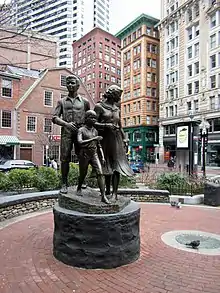History of Boston
The history of Boston plays a central role in American history. In 1630, Puritan colonists from England founded Boston, which quickly became the political, commercial, financial, religious and educational center of the New England region. The American Revolution erupted in Boston, as the British retaliated harshly for the Boston Tea Party and the patriots fought back. They besieged the British in the city, with a famous battle at Breed's Hill in Charlestown on June 17, 1775 (which was lost by the colonists, but inflicted great damage against the British) and won the Siege of Boston, forcing the British to evacuate the city on March 17, 1776. However, the combination of American and British blockades of the town and port during the conflict seriously damaged the economy, and the population fell by two thirds in the 1770s.
.jpg.webp)
The city recovered after 1800, re-establishing its role as the transportation hub for the New England region with its network of railroads, and even more importantly, the intellectual, educational and medical center of the nation. Along with New York, Boston was the financial center of the United States in the 19th century, and was especially important in funding railroads nationwide. In the Civil War era, it was the base for many anti-slavery activities. In the 19th century the city was dominated by an elite known as the Boston Brahmins. They faced the political challenge coming from Catholic immigrants. The Irish Catholics, typified by the Kennedy Family, took political control of the city by 1900.
The industrial foundation of the region, financed by Boston, reached its peak around 1950; thereafter thousands of textile mills and other factories were closed down and the city went into decline. By the 21st century the city's economy had recovered and was centered on education, medicine, and high technology—notably biotechnology, while the many surrounding towns became residential suburbs.
Prehistoric era
The Shawmut Peninsula was originally connected to the mainland to its south by a narrow isthmus, Boston Neck, and surrounded by Boston Harbor and the Back Bay, an estuary of the Charles River. Several prehistoric Native American archaeological sites, including the Boylston Street Fishweir, excavated during construction of buildings and subways in the city, have shown that the peninsula was inhabited as early as 7,500 years Before Present.[1]
Founding

In 1625, William Blaxton, an early English settler, decided to live alone on the Shawmut Peninsula[2] after most of his fellow travelers of the Ferdinando Gorges expedition returned to England. He became the first European colonist to settle in Boston.
A group of English Puritans founded the Plymouth Colony in 1620, just to the south of Massachusetts Bay. The Puritans encouraged further colonial settlement and immigration to the New World because King Charles I of England was in favor of suppressing the religious practices of Puritans in England. Eventually in 1629, the Cambridge Agreement was signed in England among some of the Puritans, established a self-governing colony, the Massachusetts Bay Colony, and they decided to settle to the New World. John Winthrop was their leader; he would become governor of the settlement in the New World. In a famous sermon before the Puritans' departure, "A Model of Christian Charity," Winthrop described the new colony as "a City upon a Hill."
In June 1630, the Winthrop Fleet arrived in what would later be called Salem,[3] which on account of lack of food, "pleased them not."[4] They proceeded to Charlestown, just across the river from the Shawmut Peninsula; however Charlestown pleased them less, for lack of fresh water.
William Blaxton noticed the Puritan settlement, and invited them to move to the Shawmut peninsula, for the peninsula had an "excellent spring" on the north side of what is now Beacon Hill.[5] The Puritans accepted, acquired the land on the peninsula from Blaxton[6] and Chickatawbut, the Native American sachem.[7] The Puritans eventually settled around the spring near the Beacon Hill; their settlement would eventually become today's Boston.[4] They granted Blaxton some lands in return, which eventually evolves into today's Boston Common.
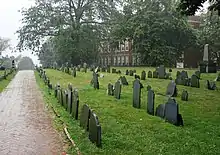
The Puritan settlers initially named the peninsula that would later become the heart of Boston as "Trimountaine,"[6] the name was derived from a set of three prominent hills on the peninsula, two of which were leveled as the city was modernized.[8] The middle one, Beacon Hill, shortened between 1807 and 1824, remains to this day as a prominent feature of the Boston cityscape.[9] Tremont Street still carries an alternative form of the original name.[10] The two smaller peaks were Cotton Hill (named after John Cotton, but later Pemberton Hill, at what is now Pemberton Square) and Mt. Whoredom (or Mt. Vernon, formerly at the location of the modern-day Louisburg Square).[11]
Governor Winthrop announced the foundation of the town of Boston on September 7, 1630 (Old Style),[12][13] with the place named after the town of Boston, in the English county of Lincolnshire, from which several prominent colonists emigrated. The name also derives from Saint Botolph, who is the patron saint of travelers.[14][15]
Colonial era

Early colonists believed that Boston was a community with a special covenant with God, as captured in Winthrop's "City upon a Hill" metaphor. This influenced every facet of Boston life, and made it imperative that colonists legislate morality as well as enforce marriage, church attendance, education in the Word of God, and the persecution of sinners. One of the first schools in America, Boston Latin School (1635), and the first college in America, Harvard College (1636), were founded shortly after Boston's European settlement.
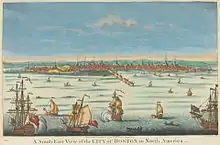
Town officials in colonial Boston were chosen annually; positions[16] included selectman, assay master, culler of staves, fence viewer, hayward, hogreeve,[17] measurer of boards, pounder,[18] sealer of leather, tithingman, viewer of bricks, water bailiff, and woodcorder.[19]
Boston's Puritans looked askance at unorthodox religious ideas, and exiled or punished dissenters. During the Antinomian Controversy of 1636 to 1638 religious dissident leader Anne Hutchinson and Puritan clergyman John Wheelwright were both banished from the colony.[20] Baptist minister Obadiah Holmes was imprisoned and publicly whipped in 1651 because of his religion and Henry Dunster, the first president of Harvard College during the 1640s–50s, was persecuted for espousing Baptist beliefs. By 1679, Boston Baptists were bold enough to open their own meetinghouse, which was promptly closed by colonial authorities. Expansion and innovation in practice and worship characterized the early Baptists despite the restrictions on their religious liberty.[21] On June 1, 1660, Mary Dyer was hanged on Boston Common for repeatedly defying a law banning Quakers from being in the colony.
A "History of Boston" would not be complete without discussing John Hull, the pine tree shilling, his central role in the establishment of the Massachusetts Bay Colony and the Old South Church. In 1652 the Massachusetts legislature authorized John Hull to produce coinage (mintmaster). "The Hull Mint produced several denominations of silver coinage, including the pine tree shilling, for over 30 years until the political and economic situation made operating the mint no longer practical." Mostly political for Charles II deemed the "Hull Mint" high treason in the United Kingdom which had a punishment of Hanging, drawing and quartering. "On April 6, 1681, Edward Randolph (colonial administrator) petitioned the king, informing him the colony was still pressing their own coins which he saw as high treason and believed it was enough to void the charter. He asked that a writ of Quo warranto (a legal action requiring the defendant to show what authority they have for exercising some right, power, or franchise they claim to hold) be issued against Massachusetts for the violations."[22]
The Boston Post Road connected the city to New York and the major settlements in Central and Western Massachusetts. The lower route ran near present-day U.S. 1 via Providence, Rhode Island. The upper route, laid out in 1673, left via Boston Neck and followed present-day U.S. Route 20 until around Shrewsbury, Massachusetts. It continued through Worcester, Springfield, and New Haven, Connecticut.
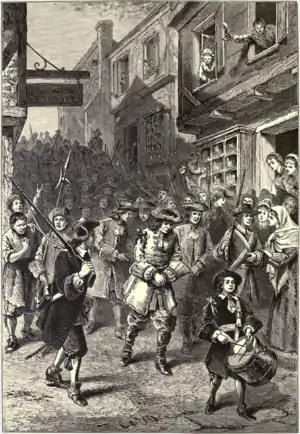
From 1686 until 1689, Massachusetts and surrounding colonies were united. This larger province, known as the Dominion of New England, was governed by Sir Edmund Andros, an appointee of King James II. Andros, who supported the Church of England in a largely Puritan city, grew increasingly unpopular. On April 18, 1689, he was overthrown due to a brief revolt. The Dominion was not reestablished.
Disasters in the 1700s
A particularly virulent sequence of six smallpox outbreaks took place from 1636 to 1698. In 1721–22, the most severe epidemic occurred, killing 844 people. Out of a population of 10,500, 5889 caught the disease, 844 (14%) died, and at least 900 fled the city, thereby spreading the virus.[23] Colonists tried to prevent the spread of smallpox by isolation. For the first time in America, inoculation was tried; it causes a mild form of the disease. Inoculation was itself very controversial because of the threat that the procedure itself could be fatal to 2% of those who were treated, or otherwise spread the disease. It was introduced by Zabdiel Boylston and Cotton Mather.[24]
In 1755, Boston endured the largest earthquake ever to hit the Northeastern United States, (estimated at 6.0 to 6.3 on the Richter magnitude scale), called the Cape Ann earthquake. There was some damage to buildings, but no deaths.[25][26]
The first "Great Fire" of Boston destroyed 349 buildings on March 20, 1760. It was one of many significant fires fought by the Boston Fire Department.
Boston and the American Revolution, 1765–1775
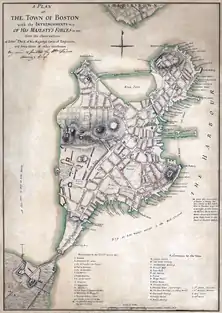
Boston had taken an active role in the protests against the Stamp Act of 1765. Its merchants avoided the customs duties which angered London officials and led to a crackdown on smuggling. Governor Thomas Pownall (1757 to 1760) tried to be conciliatory, but his replacement Governor Francis Bernard 1760–69) was a hard-liner who wanted to stamp out the opposition voices that were growing louder and louder in town meetings and pamphlets. Historian Pauline Maier says that his letters to London greatly influenced officials there, but they "distorted" reality. "His misguided conviction that the 'faction' had espoused violence as its primary method of opposition, for example, kept him from recognizing the radicals' peace-keeping efforts....Equally dangerous, Bernard's elaborate accounts were sometimes built on insubstantial evidence."[27] Warden argues that Bernard was careful not to explicitly ask London for troops, but his exaggerated accounts strongly suggested they were needed. In the fall of 1767 he warned about a possible insurrection in Boston any day, and his exaggerated report of one disturbance in 1768, "certainly had given Lord Hillsboro the impression that troops were the only way to enforce obedience in the town." Warden notes that other key British officials in Boston wrote London with the "same strain of hysteria."[28] Four thousand British Army troops arrived in Boston in October 1768 as a massive show of force; tensions escalated.

By the late 1760s Americans focused on their rights as Englishmen, especially the principle of "No Taxation without Representation," as articulated by John Rowe, James Otis, Samuel Adams and other Boston firebrands. Boston played the primary role in sparking both the American Revolution and the ensuing American Revolutionary War. The Boston Massacre came on March 5, 1770, when British soldiers fired into unarmed demonstrators outside the British custom house, resulting in the deaths of five civilians and dramatically escalating tensions.[29] Parliament, meanwhile, insisted on its right to tax the Americans and finally came up with a small tax on tea. Up and down the 13 colonies, Americans prevented merchants from selling the tea, but a shipment arrived in Boston Harbor. On December 16, 1773, 30–60 local Sons of Liberty, disguised as Native Americans, dumped 342 chests of tea in the harbor in the Boston Tea Party.[30] The Sons of Liberty decided to take action in order to defy Britain's new tax on tea, but the British government retaliated with a series of harsh laws, closing down the Port of Boston and stripping Massachusetts of its self-government.[31] The other colonies rallied in solidarity behind Massachusetts, setting up the First Continental Congress, while arming and training militia units. The British sent more troops to Boston, and made its commander General Thomas Gage the governor. Gage believed the Patriots were hiding munitions in the town of Concord, and he sent troops to capture them. Paul Revere, William Dawes, and Dr. Samuel Prescott made their famous midnight rides to alert the Minutemen in the surrounding towns, who fought the resulting Battle of Lexington and Concord in April 1775. It was the first battle of the American Revolution.
Militia units across New England rallied to the defense of Boston, and Congress sent in General George Washington to take command. The British were trapped in the city, and suffered very heavy losses in their victory at the Battle of Bunker Hill. Washington brought in artillery and forced the British out as the patriots took full control of Boston. The American victory on March 17, 1776, is celebrated as Evacuation Day. The city has preserved and celebrated its revolutionary past, from the harboring of the USS Constitution to the many famous sites along the Freedom Trail.
19th century
| Year | Pop. | ±% |
|---|---|---|
| 1722 | 10,567 | — |
| 1765 | 15,520 | +46.9% |
| 1790 | 18,320 | +18.0% |
| 1800 | 24,937 | +36.1% |
| 1810 | 33,787 | +35.5% |
| 1820 | 43,298 | +28.1% |
| 1830 | 61,392 | +41.8% |
| 1840 | 93,383 | +52.1% |
| 1850 | 136,881 | +46.6% |
| 1860 | 177,840 | +29.9% |
| 1870 | 250,526 | +40.9% |
| 1880 | 362,839 | +44.8% |
| 1890 | 448,477 | +23.6% |
| 1900 | 560,892 | +25.1% |
| 1910 | 670,585 | +19.6% |
| 1920 | 748,060 | +11.6% |
| 1930 | 781,188 | +4.4% |
| 1940 | 770,816 | −1.3% |
| 1950 | 801,444 | +4.0% |
| 1960 | 697,197 | −13.0% |
| 1970 | 641,071 | −8.1% |
| 1980 | 562,994 | −12.2% |
| 1990 | 574,283 | +2.0% |
| 2000 | 589,141 | +2.6% |
| 2010 | 617,594 | +4.8% |
| 2011 | 625,087 | +1.2% |
| * = population estimate. Source: United States Census records and Population Estimates Program data.[32][33][34][35][36][37][38][39][40][41][42][43] | ||
Economic and population growth
Boston was transformed from a relatively small and economically stagnant town in 1780 to a bustling seaport and cosmopolitan center with a large and highly mobile population by 1800. It had become one of the world's wealthiest international trading ports, exporting products like rum, fish, salt and tobacco.[44] The upheaval of the American Revolution, and the British naval blockade that shut down its economy, had caused a majority of the population to flee the city. From a base of 10,000 in 1780, the population approached 25,000 by 1800. The abolition of slavery in the state in 1783 gave blacks greater physical mobility, but their social mobility was slow.[45]
Boston was part of the New England corner of triangular trade, receiving sugar from the Caribbean and refining it into rum and molasses, partly for export to Europe. Later, confectionery manufacturing would become another refined product made from similar raw materials. Related companies with facilities in Boston included the Boston Sugar Refinery (inventors of granulated sugar), Domino Sugar, the Purity Distilling Company, Necco, Schrafft's, Squirrel Brands (as the predecessor Austin T. Merrill Company of Roxbury[46]) American Nut and Chocolate (1927)[47] This legacy continued into the 20th century; by 1950, there were 140 candy companies in Boston.[47] (Others were located in and some moved to nearby Cambridge.) The Boston Fruit Company began importing tropical fruit from the Caribbean in 1885; it is a predecessor of United Fruit Company and Chiquita Brands International.
Boston had the status of a town; it was chartered as a city in 1822.[48] The second mayor was Josiah Quincy III, who undertook infrastructure improvements in roads and sewers, and organized the city's dock area around the newly erected Faneuil Hall Marketplace, popularly known as Quincy Market. By the mid-19th century Boston was one of the largest manufacturing centers in the nation, noted for its garment production, leather goods, and machinery industries. Manufacturing overtook international trade to dominate the local economy. A network of small rivers bordering the city and connecting it to the surrounding region made for easy shipment of goods and allowed for a proliferation of mills and factories. The building of the Middlesex Canal extended this small river network to the larger Merrimack River and its mills, including the Lowell mills and mills on the Nashua River in New Hampshire. By the 1850s, an even denser network of railroads (see also List of railroad lines in Massachusetts) facilitated the region's industry and commerce. For example, in 1851, Eben Jordan and Benjamin L. Marsh opened the Jordan Marsh Department store in downtown Boston. Thirty years later William Filene opened his own department store across the street, called Filene's.
Several turnpikes were constructed between cities to aid transportation, especially of cattle and sheep to markets. A major east-west route, the Worcester Turnpike (now Massachusetts Route 9), was constructed in 1810. Others included the Newburyport Turnpike (now Route 1) and the Salem Lawrence Turnpike (now Route 114).
Brahmin elite
Boston's "Brahmin elite" developed a particular semi-aristocratic value system by the 1840s—cultivated, urbane, and dignified, the ideal Brahmin was the very essence of enlightened aristocracy.[49][50] He was not only wealthy, but displayed suitable personal virtues and character traits. The term was coined in 1861 by Dr. Oliver Wendell Holmes, Sr.[51] The Brahmin had high expectations to meet: to cultivate the arts, support charities such as hospitals and colleges, and assume the role of community leader. Although the ideal called on him to transcend commonplace business values, in practice many found the thrill of economic success quite attractive. The Brahmins warned each other against "avarice" and insisted upon "personal responsibility." Scandal and divorce were unacceptable. The total system was buttressed by the strong extended family ties present in Boston society. Young men attended the same prep schools and colleges,[52] and had their own way of talking. Heirs married heiresses. Family not only served as an economic asset, but also as a means of moral restraint. Most belonged to the Unitarian or Episcopal churches, although some were Congregationalists or Methodists. Politically, they were successively Federalists, Whigs, and Republicans.
A poem about Boston, attributed to various people, describes the city thus: "And here's to good old Boston / The land of the bean and the cod / Where Lowells talk only to Cabots / and Cabots talk only to God." While wealthy colonial families like the Lowells and Cabots (often called the Boston Brahmins) ruled the city, the 1840s brought waves of new immigrants from Europe. These included large numbers of Irish and Italians, giving the city a large Roman Catholic population.
Abolitionists
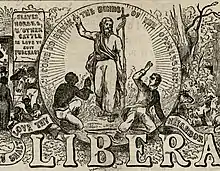
In 1831, William Lloyd Garrison founded The Liberator, an abolitionist newsletter, in Boston. It advocated "immediate and complete emancipation of all slaves" in the United States, and established Boston as the center of the abolitionist movement. After the passing of the Fugitive Slave Law of 1850, Boston became a bastion of abolitionist thought. Attempts by slave-catchers to arrest fugitive slaves often proved futile, which included the notable case of Anthony Burns and Kevin McLaughlin. After the passage of the Kansas–Nebraska Act in 1854, Boston also became the hub of efforts to send anti-slavery New Englanders to settle in Kansas Territory through the Massachusetts Emigrant Aid Company.
Irish
The earliest Irish settlers began arriving in the early 18th century. Initially they were indentured servants who came to work in Boston and New England for five to seven years, before gaining their independence. They were mainly individuals and families, and they were forced to hide their religious roots since Catholicism was banned in the Bay Colony. Then in 1718, congregations of Presbyterians from Ulster in the north of Ireland began arriving in Boston Harbor. They were referred to as Ulster Irish but later were referred to as Scots-Irish because many of them had roots in Scotland. The Puritan leaders initially sent the Ulster Irish to the fringes of the Bay Colony, where they settled places like Belfast, Maine, Londonderry and Derry, New Hampshire, and Worcester, Massachusetts. But by 1729 they were permitted to set up a church in downtown Boston.[53]
Throughout the 19th century, Boston became a haven for Irish Catholic immigrants, especially following the potato famine of 1845–49. Their arrival transformed Boston from a singular, Anglo-Saxon, Protestant city to one that has progressively become more diverse. The Yankees hired Irish as workers and servants, but there was little social interaction. In the 1850s, an anti-Catholic, anti-immigrant movement was directed against the Irish, called the Know Nothing Party. But in the 1860s, many Irish immigrants joined the Union ranks to fight in the American Civil War, and that display of patriotism and valor began to soften the harsh sentiments of Yankees about the Irish.[54] Nonetheless, as in New York City, on July 14, 1863, a draft riot attempting to raid Union armories broke out among Irish Catholics in the North End, resulting in approximately 8 to 14 deaths.[55]
Even to the present day, Boston still commands the largest percentage of Irish-descended people of any city in the United States. With an expanding population, group loyalty, and block by block political organization, the Irish took political control of the city, leaving the Yankees in charge of finance, business and higher education. The Irish left their mark on the region in a number of ways: in still heavily Irish neighborhoods such as Charlestown and South Boston; in the name of the local basketball team, the Boston Celtics; in the dominant Irish-American political family, the Kennedys; in a large number of prominent local politicians, such as James Michael Curley; in the establishment of Catholic Boston College as a rival to Harvard; and in underworld figures such as James "Whitey" Bulger.[56]
Great Fire of 1872
The Great Boston Fire of 1872 started at the corner of Summer Street and Kingston Street on November 9. In two days the conflagration destroyed about 65 acres (260,000 m²) of the city, including 776 buildings in the financial district, totaling $60 million in damage.
.jpg.webp)
High culture
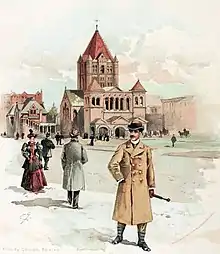
From the mid-to-late-19th century, the Boston Brahmins flourished culturally—they became renowned for its rarefied literary culture and lavish artistic patronage. Literary residents included, among many others, writers Nathaniel Hawthorne, Henry Wadsworth Longfellow, Oliver Wendell Holmes, Sr., James Russell Lowell, and Julia Ward Howe, as well as historians John Lothrop Motley, John Gorham Palfrey, George Bancroft, William Hickling Prescott, Francis Parkman, Henry Adams, James Ford Rhodes, Edward Channing and Samuel Eliot Morison. Also there were theologians and philosophers such as William Ellery Channing, Ralph Waldo Emerson and Mary Baker Eddy. When Bret Harte visited Howells, he remarked that in Boston "it was impossible to fire a revolver without bringing down the author of a two-volume work." Boston had many great publishers and magazines, such as The Atlantic Monthly (founded 1857) and the publishers Little, Brown and Company, Houghton Mifflin, and Harvard University Press.[57]
Higher education became increasingly important, principally at Harvard (based across the river in Cambridge), but also at other institutions. The Massachusetts Institute of Technology (MIT) opened in the city in 1865. The first medical school for women, The Boston Female Medical School (which later merged with the Boston University School of Medicine), opened in Boston on November 1, 1848. The Jesuits opened Boston College in 1863; Emerson College opened in 1880, and Simmons College for women in 1899.
The Brahmins were the foremost authors and audiences of high culture, despite being a minority. Emerging Irish, Jewish, and Italian cultures made little to no impact on the elite.[58]
To please a different audience, the first vaudeville theater opened on February 28, 1883, in Boston. The last one, the Old Howard in Scollay Square, which had evolved from opera to vaudeville to burlesque, closed in 1953.
The public Boston Museum of Natural History (founded in 1830 and renamed the New England Museum of Natural History in 1864, and the Boston Museum of Science in the mid-twentieth century), was run by the Boston Society of Natural History. It served the function of public and professional education in natural history, including ocean life, geology and mineralogy. Around the end of the 19th century a scientific library and children's rooms were added. In addition, the private Warren Museum of Natural History at Boston operated 1858–1906. It was acquired by the American Museum of Natural History in New York City in 1906.[59]
Transportation
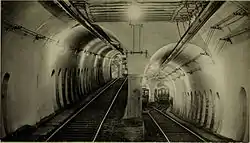
As the population increased rapidly, Boston-area streetcar lines facilitated the creation of a profusion of streetcar suburbs. Middle-class businessmen, office workers and professionals lived in the suburbs and commuted into the city by subway.[60] Downtown congestion worsened, prompting the opening of the first subway in North America on September 1, 1897, the Tremont Street Subway. Between 1897 and 1912, subterranean rail links were built to Cambridge and East Boston, and elevated and underground lines expanded into other neighborhoods from downtown. Today, the regional passenger rail and bus network has been consolidated into the Massachusetts Bay Transportation Authority. Two union stations, North Station and South Station were constructed to consolidate downtown railroad terminals.
Censorship
From the late 19th century until the mid-20th century, the phrase "Banned in Boston" was used to describe a literary work, motion picture, or play prohibited from distribution or exhibition. During this time, Boston city officials took it upon themselves to "ban" anything that they found to be salacious, immoral, or offensive: theatrical shows were run out of town, books confiscated, and motion pictures were prevented from being shown—sometimes stopped in mid-showing after an official had "seen enough". The phrase "banned in Boston" came to suggest something sexy and lurid; some distributors advertised that their products had been banned in Boston, when in fact they had not.
20th century
.jpg.webp)

Early decades
In 1900, Julia Harrington Duff (1850–1932) became the first woman from the Irish Catholic community to be elected to the Boston School Committee. Extending her role as teacher and mother she became an ethnic spokesperson as she confronted the power of the Yankee Protestant men of the Public School Association. She worked to replace 37-year-old textbooks, to protect the claims of local Boston women for career opportunities in the school system, and to propose a degree-granting teachers college. In 1905, the 25 member committee was reduced to five, which blocked women's opportunities for direct participation in school policies.[61]
Around the start of the 20th century, caught up in the automobile revolution, Boston was home to the Porter Motor Company,[62] headquartered in the Tremont Building, 73 Tremont Street.[63]
On January 15, 1919, the Great Molasses Flood occurred in the North End. Twenty-one people were killed and 150 injured as an immense wave of molasses, which rushed through the streets at an estimated 35 miles per hour (56 km/h), crushed and asphyxiated many of the victims to death. It took over six months to remove the molasses from the cobblestone streets, theaters, businesses, automobiles, and homes. Boston Harbor ran brown until summer.[64]
During the summer of 1919, over 1,100 members of the Boston Police Department went on strike. Boston fell prey to several riots as there were minimal law officers to maintain order in the city. Calvin Coolidge, then governor of Massachusetts, garnered national fame for quelling violence by almost entirely replacing the police force. The 1919 Boston Police Strike would ultimately set precedent for police unionization across the country.
On August 23, 1927, Italian anarchists Nicola Sacco and Bartolomeo Vanzetti were sent to the electric chair after a seven-year trial in Boston. Their execution sparked riots in London, Paris and Germany, and helped to reinforce the image of Boston as a hotbed of intolerance and discipline.
The Great Depression began in October, 1929, when the economic expansion of the came to an end. "Although the American stock market had sustained steep losses the last week in October of 1929, Tuesday, October 29th is remembered as the beginning of the Great Depression. The Boston Stock Exchange, drawn into the whirlpool of panic selling that beset the New York Stock Exchange, lost over 25 percent of its value in two days of frenzied trading. The BSE, nearly 100 years old at the time, had helped raise the capital that had funded many of the Commonwealth's factories, railroads, and businesses. "[65] Governor of Massachusetts Frank G. Allen appointed John C. Hull the first Securities Director of Massachusetts. [66] [67][68] Hull would assume office in January 1930. His term would end in 1936. [69]
Mid-century transportation and urban renewal

The I-695 Inner Belt shown on this map was never built. I-95 is shown here approaching the urban core from the southwest, but it was never built beyond the outer loop shown on this map (which was built as Route 128 and which I-95 was later re-routed over).
In 1934, the Sumner Tunnel created the first direct road connection under Boston Harbor, between the North End and East Boston.
In May 1938, the first public housing project, Old Harbor Village was opened in South Boston.[70]
By 1950, Boston was slumping. Few major buildings were being built anywhere in the city. Factories were closing and moving their operations south, where labor was cheaper. The assets Boston had—excellent banks, hospitals, universities and technical know-how—were minimal parts of the U.S. economy. To combat this downturn, Boston's politicians enacted urban renewal policies, which resulted in the demolition of several neighborhoods, including the New York Streets district in the South End, the old West End, a largely Jewish and Italian neighborhood, and Scollay Square. In their places went a new headquarters for the Boston Herald, the Charles River Park apartment complex, additions to Massachusetts General Hospital, and Government Center. These projects displaced thousands, closed hundreds of businesses, and provoked a furious backlash, which in turn ensured the survival of many historic neighborhoods.
In 1948, William F. Callahan had published the Master Highway Plan for Metropolitan Boston. Parts of the financial district, Chinatown, and the North End were demolished to make way for construction. By 1956, the northern part of the Central Artery had been constructed, but strong local opposition resulted in the southern downtown portion being built underground. The Dewey Square Tunnel connected downtown to the Southeast Expressway. In 1961, the Callahan Tunnel opened, paralleling the older Sumner Tunnel.
By 1965, the first Massachusetts Turnpike Extension was completed from Route 128 to near South Station. The proposed Inner Belt in Boston, Cambridge, Brookline, and Somerville was canceled due to public outcry. In 1971, public protest canceled the routing of I-95 into downtown Boston. Demolition had already begun along the Southwest Corridor, which was instead used to re-route the Orange Line and Amtrak's Northeast Corridor.
World War II and later
On November 28, 1942, Boston's Cocoanut Grove nightclub was the site of the Cocoanut Grove fire, the deadliest nightclub fire in United States history, killing 492 people and injuring hundreds more.
During the war years, antisemitic violence escalated in Boston. Gangs largely composed of Irish Catholic youths desecrated Jewish cemeteries and synagogues, vandalized Jewish stores and homes, and physically assaulted Jews in the streets. The Boston police force, which was made up largely of Irish Catholics, seldom intervened.[71]
In 1950, the Great Brink's Robbery was committed; at the time it was the largest bank robbery in the United States, with the thieves stealing $2.775 million.
In 1953, the Columbia Point public housing projects were completed on the Dorchester peninsula. There were 1,502 units in the development on 50 acres (200,000 m2) of land. In 1966, the Columbia Point Health Center opened and was the first community health center in the country.
Between June 14, 1962, and January 4, 1964, as many as thirteen single women between the ages of 19 and 85 were murdered in Boston by the infamous Boston Strangler. (The actual number remains in dispute.)
In March 1965, an investigative study of property tax assessment practices published by the National Tax Association of 13,769 properties sold within the City of Boston from January 1, 1960 to March 31, 1964 found that the assessed values in the neighborhood of Roxbury in 1962 were at 68 percent of market values while the assessed values in West Roxbury were at 41 percent of market values, and the researchers could not find a nonracial explanation for the difference.[72][73] Under the tenure of John F. Collins as Mayor of Boston (1960–1968), the Boston Housing Authority segregated the public housing developments in the city as well, moving black families into the development at Columbia Point while reserving developments in South Boston for white families who started refusing assignment to the Columbia Point project by the early 1960s.[74] In 1962, upon receipt of a lawsuit filed by a civil rights group, the West Broadway Housing Development was desegregated after having been designated by the city for white-only occupancy since 1941. In the same year, the Mission Hill project had 1,024 families (all white), while the Mission Hill Extension project across the street had 580 families (of which 500 were black), and in 1967 when the city government agreed to desegregate the developments, the projects were still 97 percent white and 98 percent black respectively.[75]

In the 1970s, after years of economic downturn, Boston boomed again. Financial institutions were granted more latitude, more people began to play the market, and Boston became a leader in the mutual fund industry. Health care became more extensive and expensive, and hospitals such as Massachusetts General Hospital, Beth Israel Deaconess Medical Center, and Brigham and Women's Hospital led the nation in medical innovation and patient care. Higher education also became more expensive, and universities such as Harvard, MIT, Boston College, BU and Tufts attracted hordes of students to the Boston area; many stayed and became permanent residents. MIT graduates, in particular, founded many successful high-tech companies, which made Boston second only to Silicon Valley as a high-tech center.
In 1974, the city dealt with a crisis when a federal district court judge, W. Arthur Garrity, ordered desegregation busing to integrate the city's public schools. Racially motivated violence erupted in several neighborhoods (many white parents resisted the busing plan). Public schools—particularly public high schools—became scenes of unrest and violence. Tension continued throughout the mid-1970s, reinforcing Boston's reputation for discrimination. A famous photograph, The Soiling of Old Glory, was taken in front of Boston City Hall, viscerally depicting the conflict.
The Columbia Point housing complex deteriorated until only 350 families remained living there in 1988. In 1984, the city of Boston gave control of the complex to a private developer, Corcoran-Mullins-Jennison, who re-developed and re-vitalised the property into a residential mixed-income community called Harbor Point Apartments. It is a very significant example of revitalisation and re-development and was the first federal housing project to be converted to private, mixed-income housing in the USA. Harbor Point has won much acclaim for this transformation, including awards from the Urban Land Institute, the FIABCI Award for International Excellence, and the Rudy Bruner Award for Urban Excellence.[76][77][78][79] It was used as a model for the federal HUD HOPE VI public housing program begun in 1992.[80]
On March 18, 1990, the largest art theft in modern history occurred in Boston. Twelve paintings, collectively worth over $100 million, were stolen from the Isabella Stewart Gardner Museum by two thieves posing as police officers. The paintings were not recovered.
Big Dig and public transit in the 2000s
.jpg.webp)
In 2007, the Central Artery/Tunnel project was completed. Nicknamed the Big Dig, it had been planned and approved in the 1980s under Massachusetts governor Michael Dukakis. With construction beginning in 1991, the Big Dig moved the remainder of the Central Artery underground, widened the north-south highway, and created local bypasses to prevent east-west traffic from contributing to congestion. The Ted Williams Tunnel became the third highway tunnel to East Boston and Logan International Airport as part of the project. The Big Dig also produced the landmark Zakim Bunker Hill Bridge, and will create over 70 acres (280,000 m²) of public parks in the heart of the city. The project as a whole has eased (but not eliminated) Boston's notorious traffic congestion; however, it is the most expensive construction project in United States history.[81]
The city also saw other transportation projects, including improvement and expansion to its mass transit system, notably to its commuter rail system to southeastern Massachusetts and the development of a bus rapid transit (BRT) system dubbed "The Silver Line." The maritime Port of Boston and Logan International Airport were also developed.
21st century
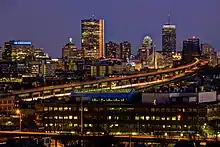
Recently, Boston has experienced a loss of regional institutions and traditions, which once gave it a very distinct social character, as it has become part of the northeastern megalopolis. Examples include: the acquisition of the Boston Globe by The New York Times; the loss of Boston-headquartered publishing houses (noted above); the acquisition of the century-old Jordan Marsh department store by Macy's; and the loss to mergers, failures, and acquisitions of once-prominent financial institutions such as Shawmut Bank, BayBank, Bank of New England, and Bank of Boston. In 2004, this trend continued as Charlotte-based Bank of America acquired FleetBoston Financial, and P&G has announced plans to acquire Gillette.
Despite these losses, Boston's ambiance remains unique among world cities and, in many ways, has improved in recent years—racial tensions have eased dramatically, city streets bustle with a vitality not seen since the 1920s, and once again Boston has become a hub of intellectual, technological, and political ideas. Nevertheless, the city had to tackle gentrification issues and rising living expenses. According to Money Magazine, Boston is one of the world's 100 most expensive cities.[82]
Boston was the host city of the 2004 Democratic National Convention. The city also found itself at the center of national attention in early 2004 during the controversy over same-sex marriages. After the Massachusetts Supreme Judicial Court ruled that such marriages cannot be banned under the state's constitution, opponents and supporters of such marriages converged on the Massachusetts State House as the state legislature voted on a state constitutional amendment that would define marriage as only between a man and a woman. Much attention was focused on the city and the rest of Massachusetts when marriage licenses for same-sex couples were issued.
Also in 2004, the Boston Red Sox won their first World Series in 86 years, following it up three years later with a victory in 2007, another in 2013, and another World Series win in 2018. Boston sports continue to dominate.
On April 15, 2013, two bombs were detonated during the Boston Marathon, killing three people and injuring hundreds.
On August 20, 2017 the .boston top-level internet domain (GeoTLD) officially started taking registrations.[83]
Geographic expansion
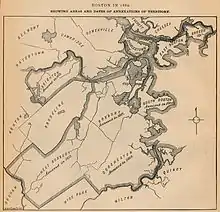
The City of Boston has expanded in two ways—through landfill and through annexation of neighboring municipalities.
Between 1630 and 1890, the city tripled its physical size by land reclamation, specifically by filling in marshes and mud flats and by filling gaps between wharves along the waterfront, a process Walter Muir Whitehill called "cutting down the hills to fill the coves." The most intense reclamation efforts were in the 19th century. Beginning in 1807, the crown of Beacon Hill was used to fill in a 50-acre (20 ha) mill pond that later became the Bulfinch Triangle (just south of today's North Station area). The present-day State House sits atop this shortened Beacon Hill. Reclamation projects in the middle of the century created significant parts of the areas now known as the South End, West End, Financial District, and Chinatown. After The Great Boston Fire of 1872, building rubble was used as landfill along the downtown waterfront.
The most dramatic reclamation project was the filling in of the Back Bay in the mid to late 19th century. Almost six hundred acres (240 hectares) of brackish Charles River marshlands west of the Boston Common were filled in with gravel brought in by rail from the hills of Needham Heights.
Boston also grew by annexing the adjacent communities of East Boston, Roxbury, Dorchester, West Roxbury (including Jamaica Plain and Roslindale), South Boston, Brighton, Allston, Hyde Park, and Charlestown, some of which were also augmented by landfill reclamation. Several proposals to regionalize municipal government failed due to concerns about loss of local control, corruption, and Irish immigration, including:[84]
- 1896 – "County of Boston" proposal in the state legislature
- 1910 – "Real Boston" proposal by Edward Filene to create a regional advisory board
- 1912 – "Greater Boston" proposal by Daniel J. Kiley that would have enlarged the City of Boston to include all 32 municipalities within 10 miles
- 1919 – Annexation proposal by Boston Mayor Andrew Peters
The state government has regionalized some functions in Eastern Massachusetts, including the Massachusetts Bay Transportation Authority (public transit), the Massachusetts Water Resources Authority (water and sewer), and the Metropolitan District Commission (parks, later folded into the statewide Department of Conservation and Recreation).

Timeline of annexations, secessions, and related developments (incomplete):
- 1705 – Hamlet of Muddy River split off to incorporate as Brookline
- 1804 – First part of Dorchester by act of the state legislature[85]
- 1851 – West Roxbury (including Jamaica Plain and Roslindale) is split off from Roxbury as an independent municipality.
- 1855 – Washington Village, part of South Boston, by act of the state legislature[85]
- 1868 – Roxbury
- 1870 – Last part of Dorchester
- 1873 – Boston-Brookline annexation debate of 1873 (Brookline was not annexed)
- 1874 – West Roxbury, including Jamaica Plain and Roslindale (approved by voters in 1873)[85]
- 1874 – Town of Brighton (including Allston) (approved by voters in 1873)[85]
- 1874 – Charlestown (approved by voters in 1873)[85]
- 1912 – Hyde Park[86]
- 1986 – Vote to create Mandela from parts of Roxbury, Dorchester, and the South End passes locally but fails citywide.
Timeline of land reclamation (incomplete):
- 1857 – Filling of the Back Bay begins
- 1882 – Present-day Back Bay fill complete
- 1890 – Charles River landfill reaches Kenmore Square, formerly the western end of the Back Bay mill pond
- 1900 – Back Bay Fens fill complete
 Original Boston shoreline vs. 1903
Original Boston shoreline vs. 1903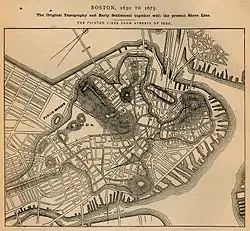 Boston in 1630 vs. 1880. The original area of the Shawmut Peninsula was substantially expanded by landfill.
Boston in 1630 vs. 1880. The original area of the Shawmut Peninsula was substantially expanded by landfill.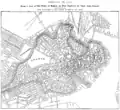 Boston in 1772 vs. 1880
Boston in 1772 vs. 1880_map.jpg.webp) Greater Boston in 1850 (Middlesex Canal highlighted)
Greater Boston in 1850 (Middlesex Canal highlighted).jpg.webp) A larger view of Boston in 1888 (see also Colonial wide-area view, 1814 map, 1842 map, 1880 railroad map, 1903 map)
A larger view of Boston in 1888 (see also Colonial wide-area view, 1814 map, 1842 map, 1880 railroad map, 1903 map)
See also
Notes
- "Archaeology of the Central Artery Project: Highway to the Past". Commonwealth Museum – Massachusetts Historical Commission. 2008. Retrieved April 6, 2007.
- Horsford, Eben Norton, The Indian Names of Boston, and their Meaning, John Wilson and Son, Cambridge, MA, University Press, 1886.
- "World Chronology – 1630". Answers.com. 2007.
- Weston, George F. Boston Ways: High, By & Folk, Beacon Press: Beacon Hill, Boston, p.11–15 (1957).
- Shurtleff, Nathaniel B., A Topographical and Historical Description of Boston, printed by request of Boston City Council, Boston, 1871.
- Bacon, Edwin M. (March 1891). "Boston Illustrated (Chapter 1)". Houghton, Mifflin and Company. Retrieved October 3, 2012.
- OBJECT OF THE MONTH OBJECT OF THE MONTH ARCHIVE ABOUT Indian deed for Boston, March 19, 1685, September 2006, Carrie Supple, Assistant Reference Librarian https://www.masshist.org/object-of-the-month/objects/indian-deed-for-boston-2006-09-01
- Whitehill, Walter Muir (1968). Boston: A Topographical History (Second ed.). Cambridge, Mass., Belknap Press of Harvard University Press. pp. 3–4, 105–109.
- Whitehill, Walter Muir (1968). Boston: A Topographical History (Second ed.). Cambridge, Mass., Belknap Press of Harvard University Press. pp. 81–84.
- "Boston Charter Day". Bostoncharterday.org. 2007. Retrieved September 25, 2008.
- "MHC Reconnaissance Survey Town Report: Boston" (PDF). Massachusetts Historical Commission. January 1981. Retrieved August 23, 2009.
- "Archived copy". Archived from the original on April 20, 2013. Retrieved March 20, 2013.CS1 maint: archived copy as title (link)
- Drake, Samuel Adams (1872). Old Landmarks and Historic Personages of Boston. p. 6.
- Kay, Jane Holtz, Lost Boston, Amherst : University of Massachusetts Press, 2006. ISBN 9781558495272. Cf. p.4
- Thurston, H. (1907). "St. Botulph." The Catholic Encyclopedia. New York: Robert Appleton Company. Retrieved June 17, 2014 from New Advent: http://www.newadvent.org/cathen/02709a.htm
- Robert Francis Seybolt. The Town Officials of Colonial Boston, 1634–1775. Cambridge, Mass.: Harvard University Press, 1939
- Hogreeve: "chiefly in New England and south-eastern Canada: a person appointed to impound stray pigs, and to prevent or assess any damage caused by them;" cf. Oxford English Dictionary, 3rd ed. 2010
- Pounder: "a person whose occupation it is to pound cattle or other livestock;" cf. Oxford English Dictionary, 3rd ed. 2010
- Woodcorder: "a town official responsible for stacking cut wood for sale into standard ‘cords’ piles;" cf. Oxford English Dictionary, 3rd ed. 2010
- Battis, Emery (1962). Saints and Sectaries: Anne Hutchinson and the Antinomian Controversy in the Massachusetts Bay Colony. Chapel Hill: University of North Carolina Press. pp. 149–225.
- Milton P. Ryder, "Swimming Against the Current: The Strange Therapy of Persecution; The Price Paid for Religious Liberty by Some Early Massachusetts Baptists and the First Baptist Church of Boston," American Baptist Quarterly, March 2002, Vol. 21 Issue 1, pp 11–27
- https://historyofmassachusetts.org/massachusetts-bay-colony-charter-revoked
- Ballard C. Campbell, ed. American Disasters: 201 Calamities That Shook the Nation (2008) pp 21–22
- Ola Elizabeth Winslow, A destroying angel: The conquest of smallpox in colonial Boston (1974)
- John E. Ebel, "The Cape Ann earthquake of November 1755 a historical perspective on its 254th anniversary" (2009) p 2
- Ballard C. Campbell, ed. American Disasters: 201 Calamities That Shook the Nation (2008) pp 28–30
- Pauline Maier (1973). From Resistance to Revolution: Colonial Radicals and the Development of American Opposition to Britain, 1765–1776. W.W. Norton. pp. 151–52. ISBN 9780393308259.
- G. B. Warden, Boston 1689–1776 (1970) pp 213–14
- Hiller B. Zobel, The Boston Massacre (1970)
- "Coming of the American Revolution". Massachusetts Historical Society. Retrieved December 28, 2013.
- Rosa, Greg (2006). Analyzing the Boston Tea Party. New York: The Rosen group.
- "Total Population (P1), 2010 Census Summary File 1". American FactFinder, All County Subdivisions within Massachusetts. United States Census Bureau. 2010.
- "Massachusetts by Place and County Subdivision - GCT-T1. Population Estimates". United States Census Bureau. Retrieved July 12, 2011.
- "1990 Census of Population, General Population Characteristics: Massachusetts" (PDF). US Census Bureau. December 1990. Table 76: General Characteristics of Persons, Households, and Families: 1990. 1990 CP-1-23. Retrieved July 12, 2011.
- "1980 Census of the Population, Number of Inhabitants: Massachusetts" (PDF). US Census Bureau. December 1981. Table 4. Populations of County Subdivisions: 1960 to 1980. PC80-1-A23. Retrieved July 12, 2011.
- "1950 Census of Population" (PDF). Bureau of the Census. 1952. Section 6, Pages 21-10 and 21-11, Massachusetts Table 6. Population of Counties by Minor Civil Divisions: 1930 to 1950. Retrieved July 12, 2011.
- "1920 Census of Population" (PDF). Bureau of the Census. Number of Inhabitants, by Counties and Minor Civil Divisions. Pages 21-5 through 21-7. Massachusetts Table 2. Population of Counties by Minor Civil Divisions: 1920, 1910, and 1920. Retrieved July 12, 2011.
- "1890 Census of the Population" (PDF). Department of the Interior, Census Office. Pages 179 through 182. Massachusetts Table 5. Population of States and Territories by Minor Civil Divisions: 1880 and 1890. Retrieved July 12, 2011.
- "1870 Census of the Population" (PDF). Department of the Interior, Census Office. 1872. Pages 217 through 220. Table IX. Population of Minor Civil Divisions, &c. Massachusetts. Retrieved July 12, 2011.
- "1860 Census" (PDF). Department of the Interior, Census Office. 1864. Pages 220 through 226. State of Massachusetts Table No. 3. Populations of Cities, Towns, &c. Retrieved July 12, 2011.
- "1850 Census" (PDF). Department of the Interior, Census Office. 1854. Pages 338 through 393. Populations of Cities, Towns, &c. Retrieved July 12, 2011.
- "1950 Census of Population" (PDF). 1: Number of Inhabitants. Bureau of the Census. 1952. Section 6, Pages 21–7 through 21-09, Massachusetts Table 4. Population of Urban Places of 10,000 or more from Earliest Census to 1920. Retrieved July 12, 2011. Cite journal requires
|journal=(help) - United States Census Bureau. "Table 3. Annual Estimates of the Resident Population for Incorporated Places in Massachusetts: April 1, 2010 to July 1, 2011 (SUB-EST2011-03-25)". Archived from the original on March 9, 2013. Retrieved January 18, 2013.
- University Archives Colonial Boston Archived February 7, 2009, at the Wayback Machine
- Jacqueline Barbara Carr, "A Change 'as Remarkable as the Revolution Itself': Boston's Demographics, 1780–1800," New England Quarterly, Dec 2000, Vol. 73 Issue 4, pp 583–602
- "Archived copy". Archived from the original on April 30, 2014. Retrieved July 10, 2014.CS1 maint: archived copy as title (link)
- "History of American Nut & Chocolate Co. Boston Massachusetts".
- US History.com, Cities, Boston, Massachusetts
- Ronald Story, Harvard and the Boston Upper Class: The Forging of an Aristocracy, 1800–1970 (1985).
- Paul Goodman, "Ethics and Enterprise: The Values of a Boston Elite, 1800–1860," American Quarterly, Sept 1966, Vol. 18 Issue 3, pp 437–451
- Holmes entitled the first chapter of his 1861 novel Elsie Venner "The Brahmin caste of New England"; he had long been writing about the group without using the term "Brahmin."
- Ronald Story, "Harvard Students, The Boston Elite, And The New England Preparatory System, 1800–1870," History of Education Quarterly, Fall 1975, Vol. 15 Issue 3, pp 281–298
- Irish Boston: A Lively Look at Boston's Colorful Irish History, by Michael Quinlin. Published by Globe Pequot Press, 2013.
- Thomas H. O'Connor, The Boston Irish: A Political History (1995) ch 3
- Tager, Jack (2001). Boston Riots: Three Centuries of Social Violence. Boston: Northeastern University Press. pp. 133–139. ISBN 978-1555534615.
- O'Connor, The Boston Irish: A Political History (1995) ch 9
- Van Wyck Brooks, The flowering of New England (1955)
- E. Digby Baltzell (1979). Puritan Boston and Quaker Philadelphia. Transaction Publishers. pp. 286, 430. ISBN 9781412832571.
- Paul DiMaggio, Paul. "Cultural entrepreneurship in nineteenth-century Boston." in Chandra Mukerji and Michæl Schudson, eds, Rethinking Popular Culture: Contemporary Perspectives in Cultural Studies (1991) pp 374+.
- Sam Bass Warner, Streetcar suburbs (1978).
- Polly Welts Kaufman, "Julia Harrington Duff: An Irish Woman Confronts the Boston Power Structure, 1900–1905," Historical Journal of Massachusetts, 1990 18(2): 113–137, 25p. Historic
- "Stanleysteameronline.com". Archived from the original on December 4, 2008. Retrieved March 9, 2008.
- Clymer, Floyd. Treasury of Early American Automobiles, 1877–1925 (New York: Bonanza Books, 1950), p.13.
- Park, Edwards (November 24, 2004). "Eric Postpischil's Molasses Disaster Pages, Smithsonian Article". Eric Postpischil's Domain. Smithsonian Institution. 14 (8): 213–230. Retrieved December 16, 2006.
- Stock Market Crash Heralds Great Depression (massmoments.org)
- https://www.mass.gov/files/department-of-public-utilities-history_0.pdf
- https://digitalcommons.bowdoin.edu/cgi/viewcontent.cgi?article=1003&context=alumni-magazines pg 129
- https://archive.org/details/actsresolvespass1929mass/page/290/mode/2up?q=securities+division+
- 290 Acts, 1929. — Chap. 287. Chap. 2S7 An Act to provide for the more effective enforcement OF THE SALE OF SECURITIES ACT. IDENTIFIER : actsresolvespass1929mass “Section 1. Chapter twenty- five of the General Laws is hereby amended by adding thereto, under the heading, Securities Division, There shall be in the department, and under its general supervision and control, a securities division which shall be under the charge of a director.” John C. Hull was the first Securities Director appointed January 1930. His term would end in 1936. Publication date 1927-1928. pg. 102
- Vale, Lawrence J., From the Puritans to the projects: public housing and public neighbors, Harvard University Press, 2000.
- Norwood, Stephen H. (2003). "Marauding Youth and the Christian Front: Antisemitic Violence in Boston and New York during World War II". American Jewish History. 91 (2): 233–267. doi:10.1353/ajh.2004.0055. S2CID 162237834.
- Oldman, Oliver; Aaron, Henry (1965). "Assessment-Sales Ratios Under the Boston Property Tax". National Tax Journal. National Tax Association. 18 (1): 36–49. JSTOR 41791421.
- Rothstein, Richard (2017). The Color of Law: A Forgotten History of How Our Government Segregated America. New York: Liveright Publishing Corporation. pp. 170–171. ISBN 978-1631494536.
- Feldberg, Michael (2015). UMass Boston at 50: A Fiftieth-Anniversary History of the University of Massachusetts Boston. Amherst, Massachusetts: University of Massachusetts Press. p. 89. ISBN 978-1625341693.
- Rothstein, Richard (2017). The Color of Law: A Forgotten History of How Our Government Segregated America. New York: Liveright Publishing Corporation. pp. 25–26. ISBN 978-1631494536.
- "Rudy Bruner Award for Urban Excellence". Bruner Foundation. Retrieved September 3, 2013.
- Kamin, Blair. "Rethinking Public Housing" Archived October 11, 2007, at the Wayback Machine, Blueprints magazine, Summer 1997, p.4, National Building Museum, Washington, D.C.
- Roessner, Jane. "A Decent Place to Live: From Columbia Point to Harbor Point" Archived September 19, 2006, at the Wayback Machine, Boston, Northeastern University Press, 2000.
- "Boston War Zone Becomes Public Housing Dream", The New York Times, November 23, 1991.
- Cf. Roessner, p.293. "The HOPE VI housing program, inspired in part by the success of Harbor Point, was created by legislation passed by Congress in 1992."
- Susan Moir (University of Massachusetts Lowell). "Big Dig". Electronic Library of Construction – Occupational Safety and Health (CDC).
- "World's most expensive cities." Money Magazine. Accessed June 30, 2005.
- Bray, Hiawatha (August 10, 2017). "The dot-Boston domain is now open". Retrieved February 18, 2018.
The .boston domain was initially awarded to the city of Boston and the Boston Globe in 2012, but the media company sold off nearly all its interests in the venture to Minds + Machines Group Limited, a company specializing in the operation of Internet domains. The Globe retains a small ownership percentage in the new domain and will receive some revenue from the sale of .boston addresses.
- Chris Marstall (January 22, 2012). "Welcome to Megaboston". Boston Globe. Retrieved January 22, 2012.
- "New Boston and the Suburbs". Kellscraft Studio. 1999–2003.
- Lewis, Geoff; Avault, John; Vrabel, Jim (November 1999). "History of Boston's Economy, Growth and Transition 1970–1998" (PDF). Boston, Massachusetts: Boston Redevelopment Authority. p. 31. Archived from the original (PDF) on June 16, 2007.
References
- Records Relating to the Early History of Boston – Selectmen Minutes 1818–1822. City of Boston. 1909.
- Bacon, Edwin Monroe (1916). The Book of Boston: Fifty Years' Recollections of the New England Metropolis. Boston: The Pilgrim Press.
- Bacon, Edwin Monroe (1886). Boston Illustrated.
- Cole, William I. (April 1898). "Boston's Pauper Institutions". The New England Magazine. 24 (2).
- Dutton, E.P. Chart of Boston Harbor and Massachusetts Bay with Map of Adjacent Country. Published 1867. A good map of roads and rail lines in and around Boston.
- Downst, Henry P. (1916). Random Notes of Boston. Humphrey Publishing.
- Patricia Harris; David Lyon (1999). Boston. Oakland, California: Compass American Guides. ISBN 978-0-679-00284-0.
- Howard Mumford Jones; Bessie Zaban Jones (1975). The Many Voices of Boston: A Historical Anthology 1630–1975. Boston: Little, Brown and Company. ISBN 978-0-316-47282-1.
- Langford, Jane Ellen (September 26, 1997). "Colonial Boston Unearthed". Archaeology.
- Seasholes, Nancy S. (2003). Gaining ground : a history of landmaking in Boston. Cambridge, Massachusetts: MIT Press. ISBN 9780262194945.
- Shackleton, Robert (1916). The Book of Boston.* Snow, Caleb H. (1828). History of Boston : The Metropolis of Massachusetts. Boston: Abel Bowen.
- Historical 1842 map of Boston -"Boston" from Tanner, H.S. The American Traveller; or Guide Through the United States. Eighth Edition. New York, 1842.
- Winsor, Justin, Jewett, C.F. (1880). The Memorial History of Boston Including Suffolk County, Massachusetts. 1630–1880. Archived from the original on November 13, 2006.CS1 maint: multiple names: authors list (link)
- Winsor, Justin (1881). Memorial History of Boston, Vol.1. James R. Osgood Publisher.
- Winsor, Justin (1881). Memorial History of Boston, Vol.2. James R. Osgood Publisher.
- Winsor, Justin (1881). Memorial History of Boston, Vol.3. James R. Osgood Publisher.
- Winsor, Justin (1881). Memorial History of Boston, Vol.4. James R. Osgood Publisher.
Further reading
- Beatty, Jack. The Rascal King: The Life and Times of James Michael Curley, 1874–1958 (1992) online edition
- Blake, John B. Public Health in the Town of Boston, 1630–1822 (Harvard UP, 1959).
- Bridenbaugh, Carl. Cities in the Wilderness-The First Century of Urban Life in America 1625–1742 (1938) online edition
- Bridenbaugh, Carl. Cities in Revolt: Urban Life in America, 1743–1776 (1955)
- Carp, Benjamin L. Defiance of the Patriots: The Boston Tea Party and the Making of America (2010)
- Connolly, James J. The Triumph of Ethnic Progressivism: urban political culture in Boston, 1900–1925 (2009).
- Conzen, Michael P., and George King Lewis, eds. Boston: A geographical portrait (1976)
- Fischer, David Hackett. Paul Revere's Ride (Oxford UP, 1994) online edition
- Eisinger, Peter K. "Ethnic political transition in Boston, 1884–1933: Some lessons for contemporary cities." Political Science Quarterly (1978): 217–239. in JSTOR
- Formisano, Ronald P., Constance K. Burns, eds. Boston, 1700–1980: The Evolution of Urban Politics (Greenwood Press, 1984) online edition, the standard political history
- Handlin, Oscar. Boston's Immigrants: A Study in Acculturation (1941), statistical analysis of census data
- Johnson, Marilynn S. The New Bostonians: How Immigrants Have Transformed the Metro Area since the 1960s (University of Massachusetts Press, 2015) xii, 291 pp
- Jones, Howard Mumford; Jones, Bessie Zaban (1975). The Many Voices of Boston: A Historical Anthology 1630–1975. Boston: Little, Brown and Company. ISBN 978-0-316-47282-1.
- Kane, Paula M. Separatism and Subculture: Boston Catholicism, 1900–1920 (2001) online edition
- McCaughey, Robert A. Josiah Quincy 1772–1864: The Last Federalist (Harvard UP, 1974)
- Miller, John C. Sam Adams, Pioneer in Propaganda (1936)
- O'Connor, Thomas H. The Boston Irish: A Political History (1995)
- O'Toole, James M. Militant and Triumphant: William Henry O'Connell and the Catholic Church in Boston, 1859–1944 (1992)
- Russell, Francis. A City in Terror—1919--: The Boston Police Strike (1975).
- Rutman, Darrett B. Winthrop's Boston: Portrait of a Puritan Town, 1630–1649 (U of North Carolina Press, 1965).
- Sammarco, Anthony Mitchell; Price, Michael, Boston's immigrants, 1840–1925, Arcadia Publishing, Images of America series, 2000
- Sammarco, Anthony Mitchell (1995). Boston: A Century of Progress. Arcadia Publishing. ISBN 9780738538761.
- Sammarco, Anthony Mitchell, The Great Boston Fire of 1872, Arcadia Publishing, Images of America series, 1997
- Sammarco, Anthony Mitchell, Lost Boston, Pavilion Press, May 1, 2014. ISBN 978-1909815049
- Simons, D. Brenton (2008). Boston Beheld: Antique Town and Country Views. University Press of New England. ISBN 978-1-58465-740-8.
- Ulrich, Laurel Thatcher, Big Dig, Little Dig, Hidden Worlds: Boston, Common-Place, American Antiquarian Society, v.3, n.4, July 2003
- Vale, Lawrence J., "From the Puritans to the Projects: Public Housing and Public Neighbors" (Cambridge, Mass.: Harvard Press, 2000).
- Vanderwarker, Peter (1982). Boston Then and Now. Courier Dover Publications. ISBN 978-0-486-24312-2.
- Warden, Gerard B. Boston, 1689–1776 (1970), the standard history for the period
- Warner, Sam Bass. Streetcar Suburbs: The Process of Growth in Boston, 1870–1900 (2nd ed. 1978)
- Waters, John J. The Otis Family in Provincial and Revolutionary Massachusetts (1968)
- Whitehill, Walter Muir. Boston: A Topographical History, (2nd ed. Harvard UP, 1968), on geography and neighborhoods
Older titles
- Boston (1909). Records Relating to the Early History of Boston – Selectmen Minutes 1818–1822. City of Boston.
- Bacon, Edwin Munroe, and Edward, George, "Ellis Bacon's Dictionary of Boston", Houghton, Mifflin and company, 1886.
- Hartnell, Edward Mussey; McGlenen, Edward Webster; Skelton, Edward Oliver, Boston and its story, 1630–1915, City of Boston (Mass.), Printing Department, 1916.
- King, Moses, King's hand-book of Boston', Cambridge, Mass., M. King, 1878
- Quincy, Josiah, A Municipal History of the Town and City of Boston During Two Centuries from September 17, 1630 to September 17, 1830, Boston : Charles C. Little & James Brown, 1852.
External links
| Wikimedia Commons has media related to History of Boston. |
- The Boston Historical Society
- Boston Mapjunction – Over 200 historical maps since 1630 and aerial photos compared with Maps of Today
- City of Boston Archaeology Program and Lab – The City of Boston has a City Archaeologist on staff to oversee any lots of land to be developed for historical artifacts and significance, and to manage the archaeological remains located on public land in Boston, and also has a City Archaeology Program and an Archaeology Laboratory, Education and Curation Center.
- The Freedom House Photographs collection contains over 2,000 images of Roxbury people, places and events, 1950–1975 (Archives and Special Collections of the Northeastern University Libraries in Boston, MA).
- Vital Records of Boston.
- Reading and Everyday Life in Antebellum Boston: The Diary of Daniel F. and Mary D. Child
- "Boston 1960s–2000". Boston TV News Digital Library. WBGH.
- Boston Public Library. "Boston History". Research Guides / LibGuides.
- Mapping Boston History
